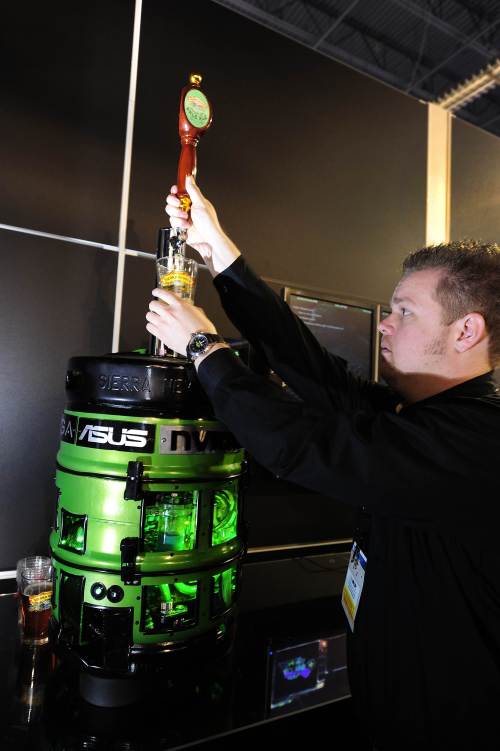SAN FRANCISCO (AP) ― Intel Corp. is paying $1.5 billion to end a fight it started with Nvidia Corp. over a key computer technology.
The legal battle centered Nvidia’s ability to make “chipsets” that are compatible with Intel’s latest processors ― a fight that has implications for many of the world’s computer users, since Intel and Nvidia’s chips are ubiquitous.
Nvidia is a top maker of graphics chips. Intel is the leader in microprocessors, the “brains” of personal computers. Both companies also made chipsets, which are used to help both types of chips talk to each other, among other jobs.
Intel sued Nvidia in February 2009, alleging that Nvidia would need to pony up for a new license to make chipsets that are compatible with Intel’s latest processors. Nvidia countersued, arguing that a license it has had in place since 2004 is sufficient.
The legal battle centered Nvidia’s ability to make “chipsets” that are compatible with Intel’s latest processors ― a fight that has implications for many of the world’s computer users, since Intel and Nvidia’s chips are ubiquitous.
Nvidia is a top maker of graphics chips. Intel is the leader in microprocessors, the “brains” of personal computers. Both companies also made chipsets, which are used to help both types of chips talk to each other, among other jobs.
Intel sued Nvidia in February 2009, alleging that Nvidia would need to pony up for a new license to make chipsets that are compatible with Intel’s latest processors. Nvidia countersued, arguing that a license it has had in place since 2004 is sufficient.

Both sides had a lot at stake. Intel needed the patent deal for access to Nvidia’s graphics technologies. Nvidia needed it because without the ability to talk to Intel’s processors, Nvidia’s chipset business would be essentially dead. Indeed, Nvidia announced in October 2009 that it was exiting the chipset business.
Intel will pay Nvidia $1.5 billion in licensing fees over the next 5 years as part of the deal announced Monday.
The reason Intel finds itself in the unlikely position of paying Nvidia is that Intel gets a license to Nvidia’s entire patent library out of the deal, while Nvidia gets a license to some of Intel’s patents, but not those covering Intel’s primary products ― particularly microprocessors and chipsets based on the so-called x86 design.
The settlement announced Monday comes as the companies are adjusting to their changing roles in the semiconductor industry, as smart phones and tablets force chip makers to design smaller and more energy efficient chips, and the explosion of high-definition content online has placed an increased premium on high-quality graphics.
Intel’s general counsel, Doug Melamed, said the settlement “preserves patent peace and provides protections that allow for continued freedom in product design.”
Nvidia’s CEO, Jen-Hsun Huang, said the “agreement signals a new era for Nvidia” and “reflects the substantial value of our visual and parallel computing technologies.”
Parallel computing is the equivalent of multitasking ― making computers process different types of data at once, an approach that’s critical for rendering graphics.
Nvidia’s Huang added that the agreement “underscores the importance of our inventions to the future of personal computing, as well as the expanding markets for mobile and cloud computing.”
Nvidia’s stock rose 3.9 percent, or 80 cents, to $20.64 in extended trading, after the agreement was announced. Intel stock gained a penny, or 0.1 percent, to $20.70.
The companies’ dispute speaks to their shifting roles.
Intel, dominant in PCs, is facing the rise of smartphones and tablets that use lower-power chip designs than the one Intel uses. Nvidia, whose graphics chips have largely been popular with gamers, is trying to boost its profile with mainstream computer users as more people stream high-definition Internet video through their computers, which is taxing for chips that aren’t specifically designed for it.
Those pressures have put Intel and Nvidia more in competition with each other. Intel has been trying to not only reduce the power consumption of its chips to get into the new types of mobile devices but also to improve its chips graphical performance ― with the aim of luring business from Nvidia. Meanwhile, Nvidia has been trashing Intel publicly, arguing that graphics chips that can do general-purpose processing as well are the future. Nvidia has also announced plans to build its own general-purpose processors based on the lower-power standard.
Intel also had to pay for another recent settlement with a rival.
In 2009 Intel agreed to pay its primary rival in microprocessors, Advanced Micro Devices Inc., $1.25 billion to settle AMD’s antitrust allegations. Monday was a big day for the semiconductor world, in that AMD’s CEO Dirk Meyer was shoved aside as the board decided it has the “opportunity to create increased shareholder value” under new leadership.
AMD’s chief financial officer, Thomas Seifert, was named interim CEO. AMD has gone through wrenching change in the past several years, including the spinoff of its chip factories in a moneysaving move after losing billions of dollars in taking on a large acquisition and battling Intel.








![[KH Explains] Hyundai's full hybrid edge to pay off amid slow transition to pure EVs](http://res.heraldm.com/phpwas/restmb_idxmake.php?idx=644&simg=/content/image/2024/04/18/20240418050645_0.jpg&u=20240419100350)






![[From the Scene] Monks, Buddhists hail return of remains of Buddhas](http://res.heraldm.com/phpwas/restmb_idxmake.php?idx=652&simg=/content/image/2024/04/19/20240419050617_0.jpg&u=20240419175937)

![[KH Explains] Hyundai's full hybrid edge to pay off amid slow transition to pure EVs](http://res.heraldm.com/phpwas/restmb_idxmake.php?idx=652&simg=/content/image/2024/04/18/20240418050645_0.jpg&u=20240419100350)

![[Today’s K-pop] Illit drops debut single remix](http://res.heraldm.com/phpwas/restmb_idxmake.php?idx=642&simg=/content/image/2024/04/19/20240419050612_0.jpg&u=)